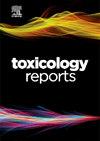靶向线粒体损伤和内质网应激抑制镉所致肾毒性铁下垂
Q1 Environmental Science
引用次数: 0
摘要
本文综述了自噬、铁凋亡和内质网(ER)应激在介导镉(Cd)引起的肾毒性中的关键作用。镉暴露导致内质网应激,进而激活主要的UPR通路,如IRE1、ATF6和PERK。通过促进脂质过氧化和抑制细胞抗氧化防御,这些机制加重了铁下垂,并产生了一种增加细胞损伤的反馈机制。自噬在镉诱导的铁凋亡中有两种作用,一种是通过分解受损成分来降低镉诱导的细胞毒性,另一种是过度自噬,即铁蛋白自噬,通过铁的失调促进铁凋亡。cd诱导的线粒体功能障碍引起的线粒体ROS (MitoROS)升高有助于铁下垂。这反过来又引起内质网应激和自噬。这意味着关注线粒体健康可能是一种有用的治疗策略。有效的治疗方法包括自噬抑制剂,如氯喹,它已被证明可以有效地减少cd诱导的铁下垂,以及有希望抑制内质网应激的药物,如TUDCA。去铁胺和其他铁螯合剂有效降低脂质过氧化和铁的失调,从而防止铁致细胞死亡。此外,建议多靶点治疗方案针对铁代谢、内质网应激和自噬。为了针对cd诱导的肾毒性创造量身定制的治疗方法,本综述强调需要进一步研究cd诱导的铁下垂的分子途径,即内质网应激自噬轴。未来研究的目标应该是将这些机制的见解应用于临床环境,以提高公共卫生结果,并为镉毒性引起的肾功能衰竭创造有效的治疗方法。本文章由计算机程序翻译,如有差异,请以英文原文为准。
Targeting mitochondrial damage and ER stress to inhibit ferroptosis in cadmium-induced nephrotoxicity
This review highlights the pivotal roles of autophagy, ferroptosis, and endoplasmic reticulum (ER) stress in mediating cadmium (Cd)-induced nephrotoxicity. Cadmium exposure results in ER stress, which in turn activates major UPR pathways such as IRE1, ATF6, and PERK. By encouraging lipid peroxidation and suppressing cellular antioxidant defence, these mechanisms worsen ferroptosis and produce a feedback mechanism that increases cellular damage. There are two roles of autophagy in Cd-induced ferroptosis, which include its action in reducing cadmium-induced cytotoxicity by breaking down damaged components, and excessive autophagy, namely ferritinophagy, which promotes ferroptosis by iron dysregulation. The rise of mitochondrial ROS (MitoROS) caused by Cd-induced mitochondrial malfunction aids ferroptosis. This, in turn, causes ER stress and autophagy. This implies that focusing on mitochondrial health could be a useful treatment strategy. Effective treatment approaches include autophagy inhibitors like chloroquine, which have been shown to effectively reduce Cd-induced ferroptosis, and promising medicines that suppress ER stress, such as TUDCA. Desferrioxamine and other iron chelators effectively lower lipid peroxidation and iron dysregulation, therefore preventing ferroptotic cell death. Additionally, a multi-targeted treatment plan is suggested that targets iron metabolism, ER stress, and autophagy. In order to create tailored treatments for Cd-induced nephrotoxicity, this review emphasizes the need for additional study into the molecular pathways of Cd-induced ferroptosis, namely the ER stress-autophagy axis. The goal of future research should be to apply these mechanistic insights to clinical settings to enhance public health outcomes and create efficient therapies for renal failure brought on by cadmium toxicity.
求助全文
通过发布文献求助,成功后即可免费获取论文全文。
去求助
来源期刊

Toxicology Reports
Environmental Science-Health, Toxicology and Mutagenesis
CiteScore
7.60
自引率
0.00%
发文量
228
审稿时长
11 weeks
 求助内容:
求助内容: 应助结果提醒方式:
应助结果提醒方式:


